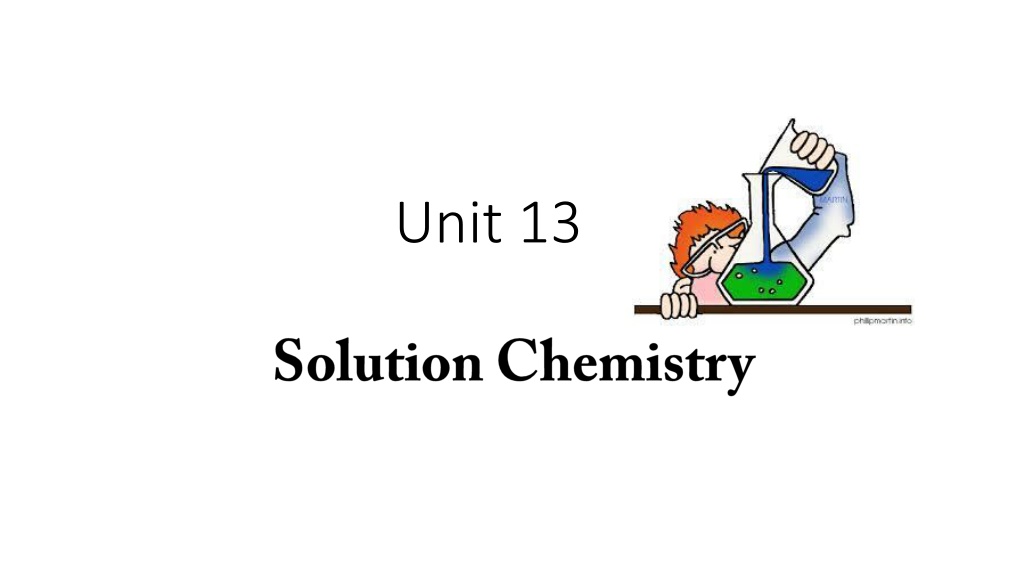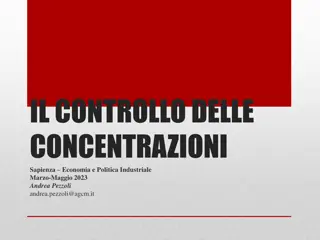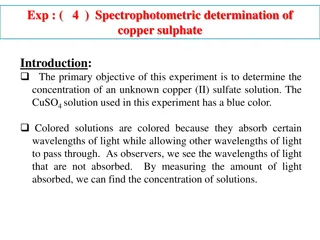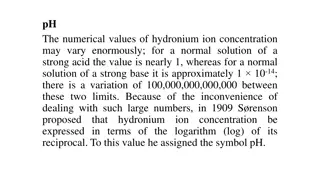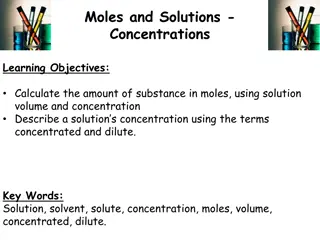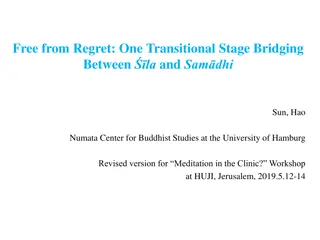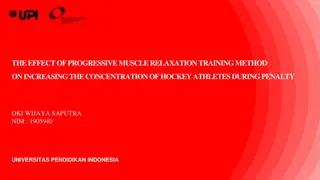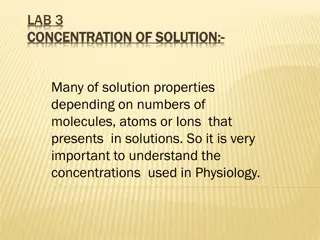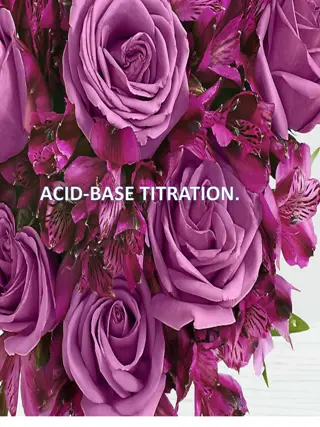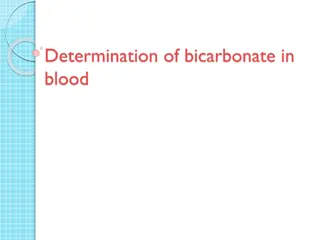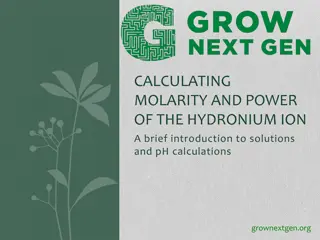Understanding Solution Concentration in Chemistry
Solutions in chemistry are homogeneous mixtures of two or more substances where each maintains its own chemical identity. They consist of a solute, the substance being dissolved, and a solvent, the substance used to dissolve the solute. Solution concentration can be described qualitatively as concentrated or dilute, or quantitatively using molarity (M), which is moles of solute per liter of solution. Concentrated solutions have a high solute:solvent ratio, while dilute solutions have a low ratio. Understanding solution concentration is crucial in chemistry experiments and applications.
Download Presentation

Please find below an Image/Link to download the presentation.
The content on the website is provided AS IS for your information and personal use only. It may not be sold, licensed, or shared on other websites without obtaining consent from the author. Download presentation by click this link. If you encounter any issues during the download, it is possible that the publisher has removed the file from their server.
E N D
Presentation Transcript
What is a solution? A is a homogeneous mixture of two or more substances in a single phase. Requirements: 1. contains two or more substances 2. each substance maintains its own chemical identity 3. the substances combine in a single phase
Circle the solutions: Gatorade Chocolate Milk Ice Cream Peanut Butter Nail Polish Distilled water Vinegar HCl (aq) Jello Shaving Cream Apple juice Salad dressing Salt water H2O(l) ocean water CuSO4(aq) pond water drinking water Soda NaCl(s)
Solutions: Gatorade Chocolate Milk Ice Cream Peanut Butter Nail Polish Distilled water Vinegar HCl (aq) Jello Shaving Cream Apple juice Salad dressing Salt water ocean water pond water drinking water H2O(l) CuSO4(aq) Soda NaCl(s)
A solution is made up of two parts, the solute and the solvent. Solute = the substance being dissolved in a solutions, usually present in a smaller amount. Solvent = the substance used to dissolve the solute, usually present in a larger amount.
Parts of a solution: Which is present in the greater amount, the solute or solvent?
Concentration of a Solution: Qualitative (Non-quantitative) description of solution concentration: Concentrated = a solution that contains a lot of solute. Dilute = a solution that contains a small amount of solute. Some descriptions of solution concentration: 1. The solution is darker or lighter in color. 2. The solution is thick, not easy to pour.
Quantitative (measured) description of solution concentration: (M) = moles solute Liter solution
Summary solution concentration Summary solution concentration word bank: concentrated, molarity, dilute ___________________ solutions have a high solute: solvent ratio. ____________________ solutions have a low solute: solvent ration ____________________ gives a quantitative measurement of solution concentration
Molarity calculations: 1. Write the equation for molarity: 1. What is the molarity of a solution containing 0.5 moles HCl in 1L solution? 2. Sea water contains roughly 28.0 g of NaCl per liter. What is the molarity of sodium chloride in sea water? 3. What is the molarity of 5.00g NaOH in 1.00 L solution? 4. How many moles of sodium carbonate (Na2CO3) are there in 1.5L of a 2.0M solution?
Dilutions: M M1 1V V1 1 = M = M2 2V V2 2 1. 100 mL of a 5.0M solution is diluted to 250 mL. Calculate the concentration (M2) M1= V1 = M2 = V2 = 2. What volume (V1) is needed to prepare 500. mL of a 1.0M NaCl solutions. The starting solution has a concentration of 2.5M. 3. Calculation the concentration (M2) of a solution prepared by diluting 25 mL of a 1.25M solution to a new volume of 150 mL.
Solubility and solutions: Solubility and solutions: likes dissolve likes Solubility = the amount of solute that can dissolve in given amount of solvent (generally water, 100g) Unsaturated solution = less than the maximum amount of solute Saturated solution = the maximum amount of solute for a given amount of solvent Supersaturated solution = more than the maximum amount of solute is dissolved for a given amount of solvent
Solubility curve: Describes the relationship of solubility and temperature ( Temp = Solubility) Think Ice tea and hot tea!
Solutions & Colligative Properties: Colligative properties are properties of solutions that depend upon the ratio of the number of solute particles to the number of solvent molecules in a solution. Properties that are affected include: Freezing point Boiling point Vapor pressure 1. The freezing point of a solvent is lowered when a solute is added to a solvent. 2. The boiling point of a solvent is raised when a solute is added to a solvent. 3. The vapor pressure of a solvent is lowered when a solute is added to a solvent.
Applications: Salting icy roads and walkways Making ice cream or freezer pops in the lab!
